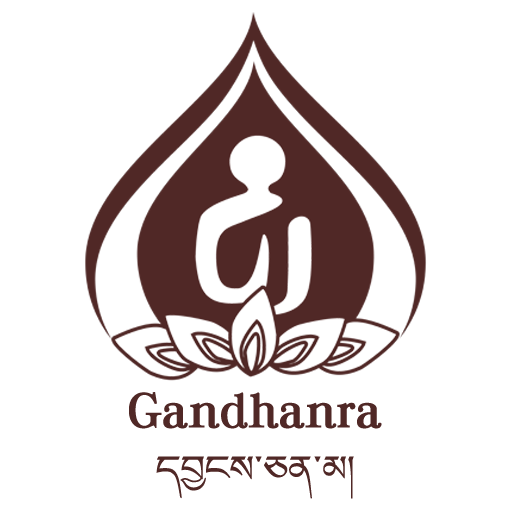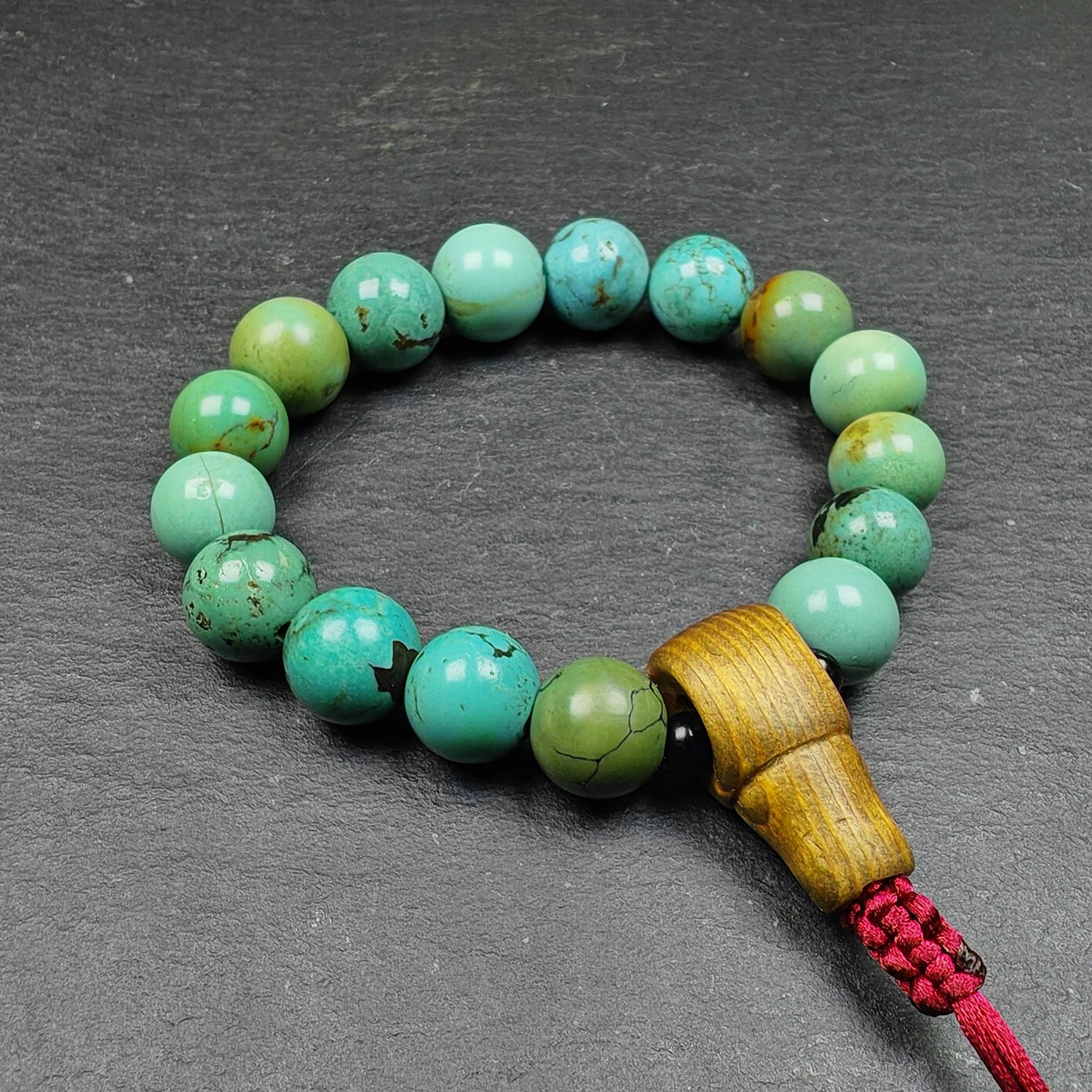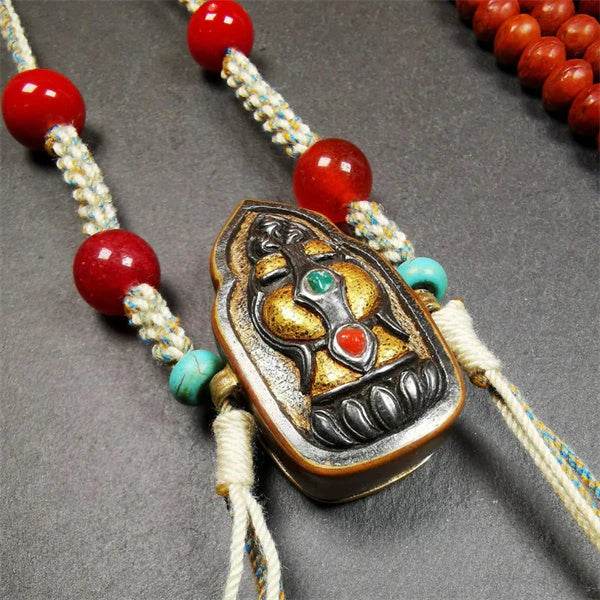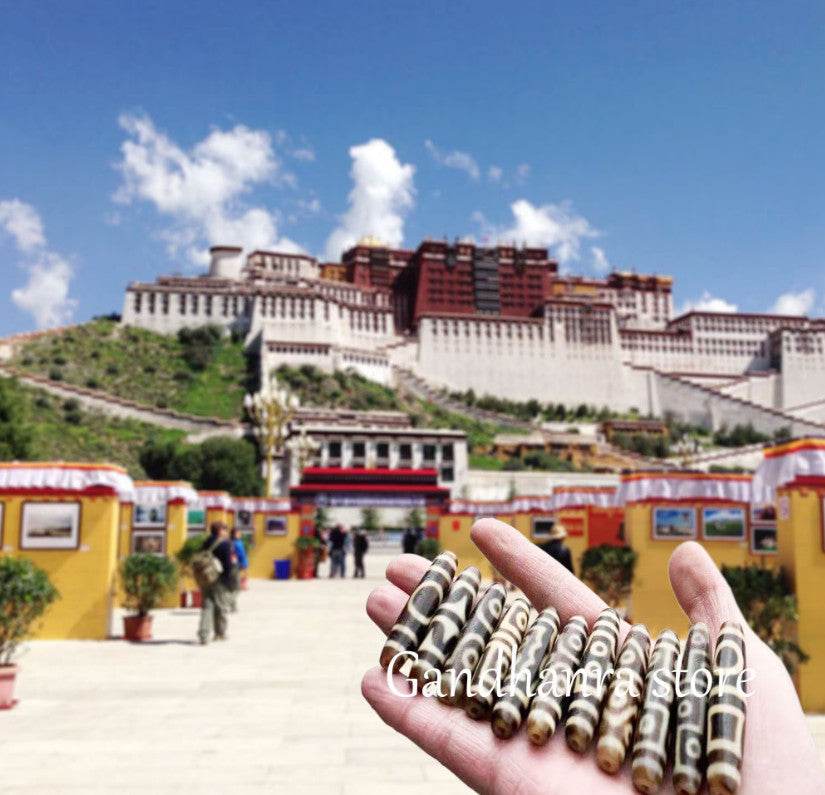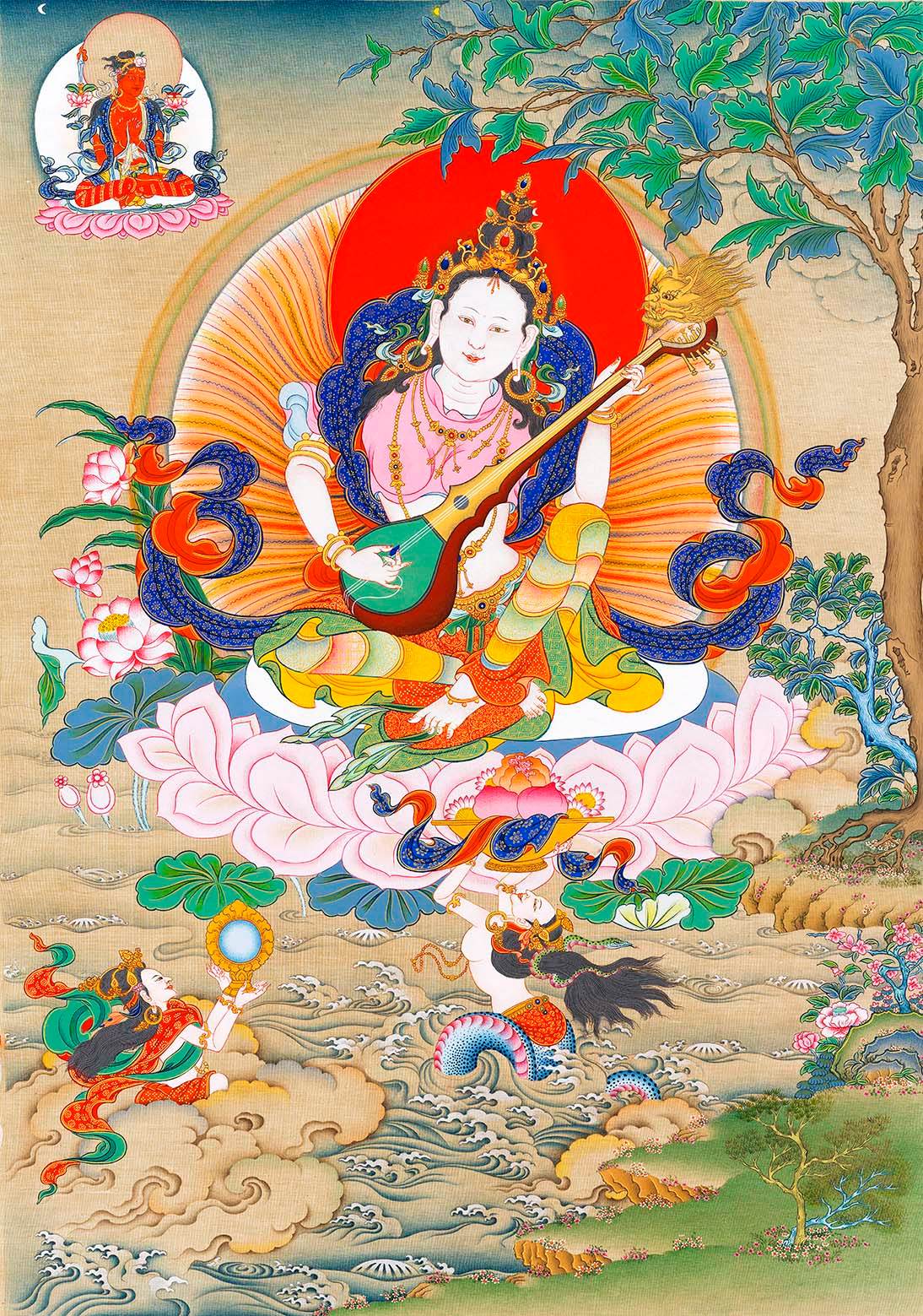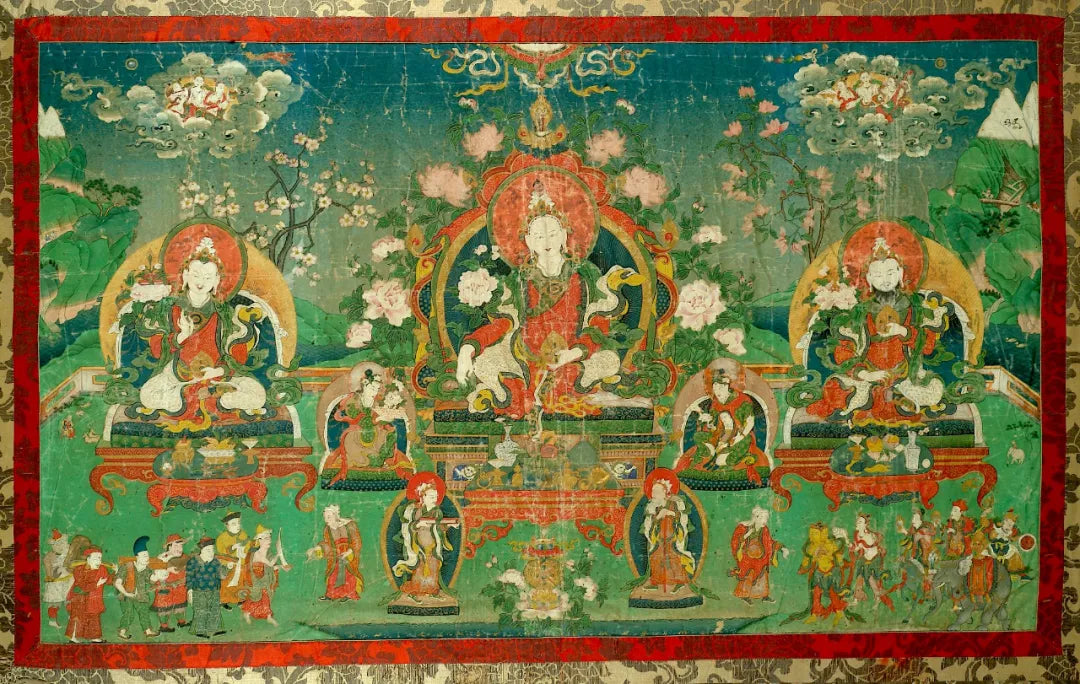
The beard in the Himalayan portrait (Part 1) ▎Accumulating wisdom and dignity
ལྟེ་དབུས་གྲུབ་པའི་དབང་ཕྱུག་ལྕགས་ཟམ་པ།
ལོ་བརྒྱ་ལོན་ཚུལ་དབུ་སྐྲ་སྨ་ར་དང།
ཨག་ཚོམ་དཀར་ལ་སྨུག་ནག་སྤྱན་གསུམ་འབར།
Iron Bridge Master sits in the center,
With frost-white hair and a beard of a hundred years,
His deep-red sacred form and three eyes bright.
(Note: The "Iron Bridge Master" here refers to Tangtong Gyalpo.)

"Tangtong Gyalpo," 19th century, Rubin Museum of Art, New York
As a master of the Shangpa Kagyu tradition (ཤངས་པ་བཀའ་བརྒྱུད་—not a branch of mainstream Kagyu), Tangtong Gyalpo (ཐང་སྟོང་རྒྱལ་པོ་; 1365–1486) embodies all Tibetan symbolic elements of the "wisdom beard." As a long-lived sage, his beard must be snow-white—a sign of accumulated wisdom and merit. As a wandering ascetic and tertön, his beard would naturally be unkempt, resembling juniper foliage, due to his austere lifestyle. As a skilled and compassionate healer, the edges of his beard would carry hues of yellow and blue—a mark of lifelong engagement with medicinal herbs (blue symbolizes healing in Tibetan medical iconography). The "deep-red sacred form" in traditional texts not only reflects his sun-weathered skin from years of wandering but also signifies the profound realization of a yogi (aligned with Buddhist color symbolism). Finally, the "three eyes" correspond to his physical eyes and the ushnisha (crown protrusion), representing discernment (ཤེས་རབ་), wisdom (ཡེ་ཤེས་), and the nature of reality (ཆོས་ཉིད་).

Detail: The Beard of Tangtong Gyalpo

partial: iron chain
Not only was Tangdong Gyalpo passionate about public healthcare,
he was also an extraordinary engineer and designer.
During his long years of wandering and spiritual practice,
he built a total of 58 suspension bridges to serve the people.

partial: Harmonious Four Friends
Artistic symbols derived from
the Jataka tales
representing a state of harmony

partial: paired cranes and paired deer
Symbols of longevity often appear among the "Six Longevities."

partial: disciple performing water offering
According to the text behind the artwork,
this disciple is likely Sherab Palden (ཤེས་རབ་དཔལ་ལྡན་; 15th–16th century),
the biographer of Tangdong Gyalpo.

*Tangdong Gyalpo*, 18th century, private collection.
Here, the hair knot is not the usual single bun,
but a crossed yogi's topknot.

*Tangdong Gyalpo*, 19th century, private collection.
The statue is a Chinese-style wooden carving.
"Men seem to find solace only in their beards," this remark by the writer Hermann Hesse (1877–1962) reminds us that beards, as the so-called "secondary sexual characteristic" of men, hold greater significance in socio-psychological and cultural analysis than their mere biological function. In Buddhist culture, retaining a beard is considered a violation of monastic discipline, as facial hair in South Asian traditions symbolizes religious identity and social status—contradicting early Buddhism's universal principles—and serves as an external manifestation of ego-attachment. However, it is important to note that during the evolution of Buddhist art, depictions of buddhas and bodhisattvas with beards occasionally emerged due to regional stylistic differences and varying social contexts.

Gandhara-style Buddha statue

*Ajita the Elder*, 19th century, private collection.
The elder dwelling on the Sage's Mountain (Drangsong Ri)
is Ajita the Elder (Maphampa).

partial: the beard of Ajita the Elder
In early texts, the Buddha's disciples were primarily centered around the "Ten Principal Disciples." By the beginning of the 4th century, Buddhist scriptures began to describe the "Sixteen Arhats." In Tibet, the classic depictions of the Sixteen Arhats originated from the teachings of Sakya Pandita's teacher, the Kashmiri scholar Śākyaśrībhadra (ཤཱཀྱ་ཤྲཱི་བྷ་དྲ་; 1127–1225) and the Kadampa scholar Dromtönpa (འབྲོམ་སྟོན་པ་; 1005–1064). In the former's description, all the arhats appear as elderly figures, while in the latter's, only a few are depicted with white beards and advanced age (with some arhats even having multiple distinct appearances).

*Vanavasin the Elder*, 17th century, Rubin Museum of Art, New York.
The highly skilled healer among the Buddha's disciples
and his personal physician
was Vanavasin the Elder (སྦེད་བྱེད་).

the beard of Vanavasin the Elder

The lion guarding the scriptures
resides on the sacred mountain Bihula (བི་ཧུ་ལ་) of the Elder.
In Tibetan, beards are generally classified into three categories: 1. The beard above the lips is called "sma ra" or "a ra" in Lhasa dialect; 2. The beard from the cheeks to the chin is called "rgya", and those with sideburns are called "rgya wo"; 3. The long beard below the lips is called "aga tshom"; 4. A small cluster of hair below the lips is called "byis ru". It should be noted that the commonly used term "kha spu" in Tibetan can refer to all beards as a whole or specifically to the thin and elongated beard that extends from the upper lip to the sides. Additionally, since beards are seen as a male decoration, there are multiple respectful terms for beards in Tibetan, such as "mouth ornament" (ཁ་རྒྱན་) and "face ornament" (ཞལ་རྒྱན་). Since the 7th century, the Tibetan region, influenced by Buddhist culture, has presented various forms of interpretation of beards.
Beard - Power

*The Three Sacred Kings of Tibet*, 19th century, Tibet House Museum, New Delhi.
Trisong Detsen - Songtsen Gampo - Tridé Tsuktsen
An iconographic paradigm of reconstructing political lineage through Buddhist ideology.
In the "Tibetan Royal Chronicles" by the Fifth Dalai Lama (1617-1682), the succession of generations and the fortune of the empire were often judged by the facial hair, reflecting the spread of Buddhism in Tibet. According to historical records of Tibetan Buddhistization since the 12th century: the 33rd King Songtsen Gampo (617-650) appeared as a beautiful young man, symbolizing the beginning of Buddhism; the 37th King Trisong Detsen (742-797) had a long beard, symbolizing the expansion of Buddhism in Tibet; and the 41st King Ralpacan (764-815) used his own braided hair as a cushion for monks and had a very thick beard, symbolizing the prosperity of Buddhism. It is worth noting that the image of Ralpacan in later generations was largely mixed with the inherent appearance of the 36th King Tride Songtsen (704-755), who was known for his long beard. The last ruler of the Tibetan Empire, Lang Darma (799-842), was known as the "Destroyer of Buddhism," and later Buddhist historians misinterpreted his epithet "Udumtsan" as "The Emperor Without Hair," signifying the decline of fortune.

*Songtsen Gampo*, 12th century, Jokhang Temple.
Songtsen Gampo in pre-Fifth Dalai Lama depictions
typically appears as a beardless youth.

*Trisong Detsen*, 18th century, private collection.
As a protector of Buddhism (particularly in the South Asian tradition),
Trisong Detsen is a paradigmatic practitioner in the Nyingma tradition
and an emblem of the "politico-religious" synthesis.

partial: the beard of Trisong Detsen

partial: the Fifth Dalai Lama
reconstructor of the "Dynastic Visual Lineage" (rgyal rabs bris rgyud).

*Tridé Tsuktsen*, 19th century, Kapoor Collection.
The French scholar Madame Macdonald described him as:
"an excellent Buddhist and a terrible monarch."

partial: the beard of Tridé Tsuktsen

U Dumtsen, mural at Palcho Monastery, photographed by the author.
Rather than labeling him a "destroyer of Buddhism,"
it is more fitting to regard him as a monarch of unfulfilled ambition.
As the founder of the Ganden Phodrang government (དགའ་ལྡན་ཕོ་བྲང་;1642-1959), the Fifth Dalai Lama sought to awaken the historical memory of unified political authority in Tibet through a "restoration movement". This movement included four aspects: 1. Building a "Tubo space" by restoring ancient sites in Lhasa and other areas; 2. Restoring titles and administrative units from the Tubo period; 3. Efforts to recreate a classical era through clothing and music (particularly during the reign of the Third Dalai Lama); 4. Structuring the history of the Tubo Empire's collapse through historical writing and artistic depiction. The Fifth Dalai Lama placed particular emphasis on the fourth aspect, which is why he wrote the "Biographies of Tibetan Ministers" in 1643. In his biography, his emphasis on his beard (known as a symbol of the Fifth Dalai Lama) aligned with the tradition of monarchy and facial hair inheritance.

Manual of Adornments Fit for Noble Persons
(ཡ་རབས་རྣམས་ལ་འོས་པའི་རིན་ཆེན་རྒྱན་ཆའི་དེབ་ཐེར་)
1673, Tibet Archives
Compiled by Desi Lobsang Thutob
By the time of the Seventh Dalai Lama (bsKal bzang rgya mtsho; 1708–1757), a set of thirteen thangka paintings emerged, centered on the "Avalokiteśvara devotion lineage," with the Seventh Dalai Lama at its core. This series linked the Dalai Lama lineage to incarnations of Avalokiteśvara and positioned it as the heir to Tibet’s political legacy. According to historical records, the Sixth Panchen Lama (Blo bzang dpal ldan ye shes; 1738–1780) presented a similar set of Dalai Lama lineage paintings to the Qianlong Emperor. In these works, the Fifth Dalai Lama’s beard was attributed to Songtsen Gampo (departing from earlier beardless youthful depictions), unifying them as sovereigns of Lhasa.

The Dalai Lama Lineage: The Fifth Dalai Lama, 18th century, private collection.

partial: the beard of the Fifth Dalai Lama

partial: Avalokiteshvara

partial: the Potala Palace

partial: political assistant
Domestic affairs: Sönam Chöpel (བསོད་ནམས་ཆོས་འཕེལ་; 1595–1658)
Foreign affairs: Gushri Khan (1582–1654)

The Dalai Lama Lineage: Songtsen Gampo, 18th century, private collection.

partial: the beard of Songtsen Gampo

partial: Eleven-Faced Avalokiteshvara

partial: the Jokhang Temple

partial: political symbolic figure
Domestic affairs: Thönmi Sambhota and Gar Tongtsen (second row)
Foreign affairs: Princesses of Nepal and Tang China (first row)
Center: Palden Lhamo, protector deity of Lhasa

The 13th Dalai Lama, 1910
As political strongmen,
the 13th and 5th are often compared,
their similar beards symbolically linked.
When beards serve as markers of political lineage in Tibetan art, painters also use facial hair to distinguish foreign monarchs. The First Jamgön Kongtrül Lodrö Thaye (འཇམ་མགོན་ཀོང་སྤྲུལ་བློ་གྲོས་མཐའ་ཡས་; 1813–1899) once wrote:"Indian rulers have full beards, like Jambhala; Han Chinese rulers bear slender mustaches; Mongolian rulers all wear great beards." Beyond such typological descriptions, Tibetan art depicts many monarchs with realism—e.g., the Yongle and Qianlong Emperors.

*Vaiśravaṇa*, 19th century, Rubin Museum of Art, New York.

partial: the beard of Vaiśravaṇa

partial: Jambhala
This type of South Asian beard is regarded as
a neatly groomed and clean style.

Śākyaśrī, mural at Palcho Monastery, photographed by the author.
Note his beard—
comparable to South Asian monarchs.

*The Ninth Karmapa*, 16th century, Rubin Museum of Art, New York.
The 9th Karmapa, Wangchuk Dorje (དབང་ཕྱུག་རྡོ་རྗེ་; 1556–1603),
traveled extensively across Tibet with numerous eminent disciples,
such as the Jonang master Tāranātha (ཏཱ་ར་ནཱ་ཐ་; 1575–1635).

partial: Mu Qing
The Mu chieftain of Lijiang who invited the Karmapa,
Mu Qing (1569–1597),
and his son Mu Zeng (བསོད་ནམས་རབ་བརྟན་; 1587–1646),
oversaw the printing of the Lijiang Kangyur.
Such were the beards of Han Chinese rulers.

partial: panoramic view of Tsurphu Monastery

Qianlong in Monastic Robes, 18th century, Palace Museum.

partial: the Qianlong Emperor

Gushri Khan, Jokhang Temple.
The red rosary symbolizes temporal power.

Partial: Khubilai Khan from Portrait of Phagpa, 17th century, Rubin Museum of Art, New York.
This article is translated from SuolangWangqing's blog.
